MechCommander 2 Preview
The final release of MechCommander 2 isn't far off. We take a look at a near complete version.
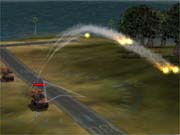
Fans of the older MechWarrior games had high hopes for the original MechCommander. When the game was finally released in 1998, most thought that it was a solid strategy game, but that it lacked polish in a few areas. With MechCommander 2, Microsoft hopes to cure most of the problems that plagued the original as well as introduce new features--like the full three-dimensional engine--that enhance the strategic element in the game. We recently received a near-complete build of MechCommander 2, and it looks as though there's very little left for the development team to work on other than some problems associated with the game's new graphics engine.
Before the start of each mission in MechCommander 2, a short full-motion video clip gives you background on the factions involved in the current battle, as well as some details on the current mission. The next screen shows a map that gives you basic information, like where your objectives are located, but it also provides valuable topographical information so that you can equip your small group of pilots with the appropriate mechs and weapons. For example, if there's a mountain range or an abundance of high-level areas on the map, a sensor specialist pilot may not be quite as useful, because you can already scout most of the land from the higher elevations. Likewise, mechs equipped with long-range weapons may be particularly useful in such a situation because they can retain their tactical advantage atop mountains at a safer distance, whereas short-range mechs would have to compromise their position and move closer to engage enemy forces. Finding a good balance between different types of mechs is crucial to completing mission objectives.
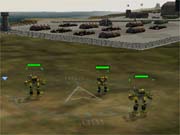
Customizing a mech for a specific mission is an easy task that fans of the MechWarrior series should be immediately familiar with. Mech customization starts with matching a pilot with the appropriate mech. If you decide that you want a mech with long-distance firing capabilities, you might want to select a pilot who specializes in those types of weapons--a pilot who's proficient with a laser would work well in this case. But again, it all comes down to the mission and the terrain. If there aren't many high areas, a sensor specialist pilot becomes much more useful for tracking enemy movements. Even when you're adding or taking weapons away from your mechs, you have to take into consideration individual pilot abilities, the type of terrain, and mission objectives. When there's a mission that requires pinpoint accuracy, you don't want to have missiles equipped on your mech, because they can do a substantial amount of unintentional damage to surrounding areas. It also wouldn't be a good idea to have rookie pilots in such a situation because their level of weapon accuracy is too unreliable. By the time you start the mission, you should have an overall idea of what your strategy is, including where you want to place your mechs and how you want to proceed through the mission. Occasionally, in some missions, it's nearly impossible to prepare adequately beforehand because there are secondary objectives that appear as the mission progresses.
Support and Mission Objectives
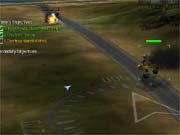
The missions you encounter in MechCommander can range from straightforward seek-and-destroy-style missions to missions in which you must successfully capture or destroy a single target without doing secondary damage to any other buildings or units in the area. To help accomplish such specialized objectives, you have access to a special support menu that lets you select from support options such as air strikes, repair trucks, sensor probes, and artillery. In some of the early missions, it's easy to take these support items for granted since you don't really use them extensively, but once the action starts to pick up in the later levels, you'll wish you had an infinite supply.
There isn't any direct form of resource management in MechCommander 2, but your support options do have a limited supply of resource points, which you deplete every time you select a support item--selecting the air strike option costs you 7,000 points, while the repair truck costs only 6,000 points. Generally, you have only enough points at a time to select one of the major support options, so there are situations in which you have to decide between ordering an air strike on an unsuspecting enemy base from a safe distance or using a repair truck to fix your mechs after a grueling battle. If you don't want to risk one or the other, you can send one of your mechs to scour the surrounding landscape for any supply bases or supply trucks that give you additional resource points.
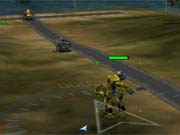
Most of MechCommander 2's major features seem to come together quite well early on in the game. In one particular mission, you have to infiltrate an enemy base that's surrounded by enemy turrets--once it's successfully captured, your mechs stay behind and wait for an enemy convoy. After you deal with the convoy and any remaining opposition, you move your forces to the northwest, where another enemy base awaits your arrival. Since turrets surround the first base, your long-range mechs become quite useful because you can place them on a mountain that surrounds the base and use them to attack enormous fuel tanks interspersed throughout the enemy base. With just a few precise hits from a laser weapon, the enemy base basically disappears in a cloud of smoke, and any remaining enemy units in the area are either severely damaged or destroyed instantly. When the enemy convoy finally arrives, your veteran pilots and their more precise aim become incredibly valuable, as you want to take out only enemy mechs and none of the actual supply units in the convoy. A larger mech equipped with a less-accurate weapon, like a missile, would be almost worthless in this situation because there's such a high risk of unintentionally destroying other units, thus prematurely ending the mission. By the time you take on the final base, chances are you might have only a few mechs left, so you can either repair those remaining mechs and try to salvage new ones or order air strikes on the final base to lower their defenses. Luckily, the last base is surrounded by higher terrain, making it easier to take out enemy targets from a safe distance, but when the enemy units swing around to the backside of the base, you have to be ready to make a split-second decision.
Salvaging Mechs and Final Thoughts

It's somewhat surprising to see just how much strategy is involved in MechCommander 2--even the smallest decisions involve strategies that can drastically affect the outcome of a mission. For example, when you encounter a salvageable mech, a number of different factors--like whether it's worth it to spend the resource points, since you need to spend points on both the salvage ship and the repair truck to get the mech back to an acceptable level--can influence your final decision. This may not seem like such an important decision early on in the game, but once the missions become tougher and your mechs are wiped out one by one by stronger enemy units, it becomes a real dilemma. Similarly, there are moments in which you approach a base that has a strong defense system, but the control base of those defense systems are fairly close to the entrance. You can risk sending in one of your fast mechs to quickly seize the control area, disabling the defense system, but your fast mech--which doesn't have strong armor--may not survive. Or you can just use brute force and destroy everything in sight; it's completely up to you.
The strong emphasis on strategy, as opposed to brute force, is largely a result of MechCommander 2's new three-dimensional engine. The new engine has let the developers incorporate features like line of sight, which lets you see enemy mechs only by getting in close range, taking higher ground, or launching a sensor probe into the area. In addition, there are basic tactical advantages for placing units at higher elevations, since opposing mechs and vehicles have a more difficult time hitting their targets. There's also a surprising amount of interaction between mechs and the environments, resulting in some nice details. Your mechs leave footprints as they travel across the environment; wake follows the mechs as they march through water; even trees topple against the weight of the mighty 50-foot-tall robots. Of course, the mech units themselves are especially impressive, since they have nearly all the details that the mechs in the MechWarrior series have.
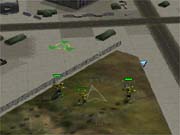
Unfortunately, the only problem with MechCommander 2's engine at this point is performance, which tends to decline as environments are populated with more objects, whether they're trees, small buildings, or just other units. This becomes a major problem during more-hectic battles, since the frame rate stutters quite often, making it difficult to maneuver the camera into a useful position and to move your units into a specified location. Even when the camera is zoomed out on the action, the unstable frame rate still presents a problem. Hopefully, Microsoft will address these issues before MechCommander 2's final release.
Despite these visual problems, MechCommander 2 should appeal to both real-time strategy fans and longtime MechWarrior fans because of the sheer amount of strategy involved in the game, as well as individual mech and pilot abilities factoring into gameplay. MechCommander is scheduled for release in July.
Got a news tip or want to contact us directly? Email news@gamespot.com
Join the conversation